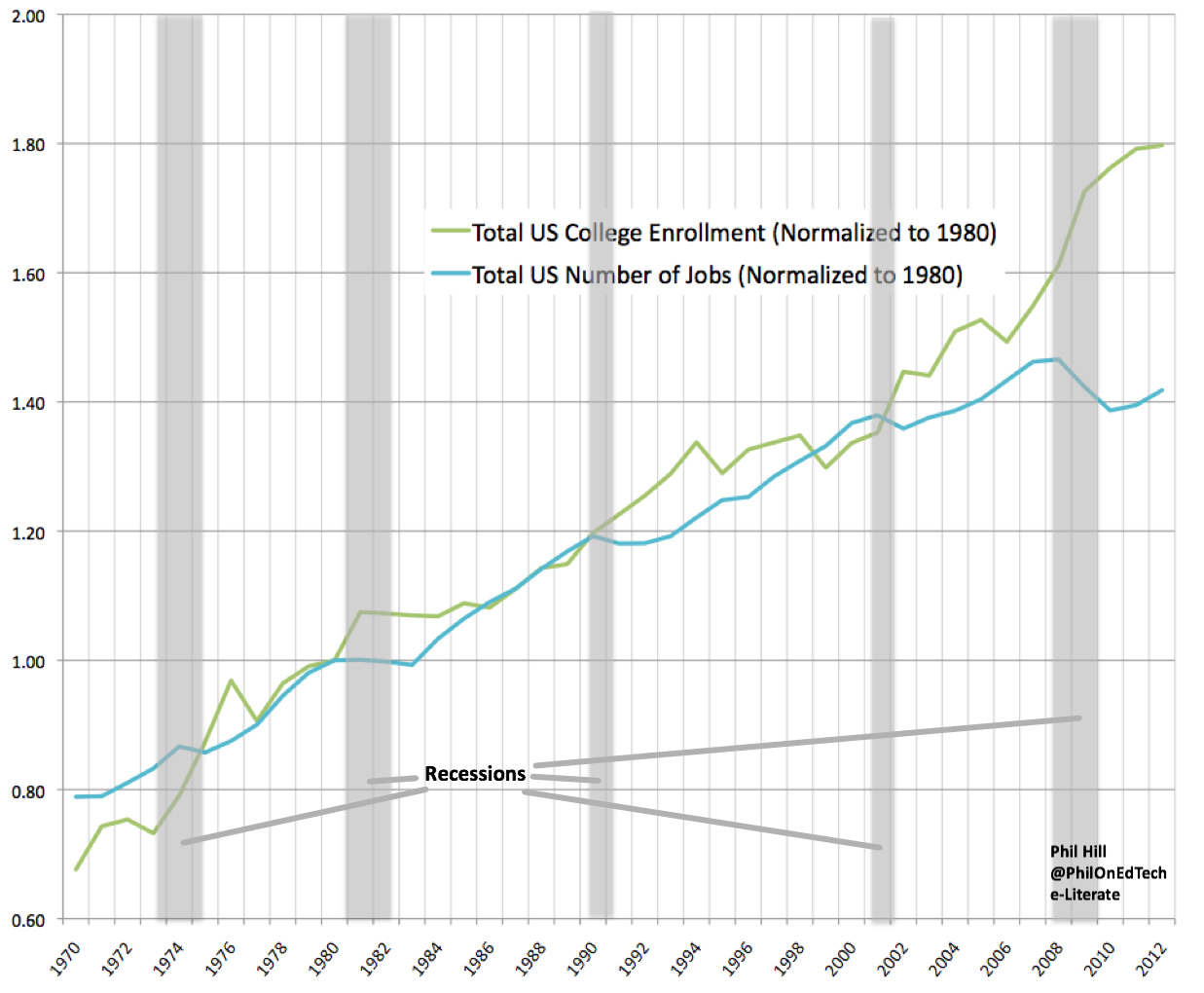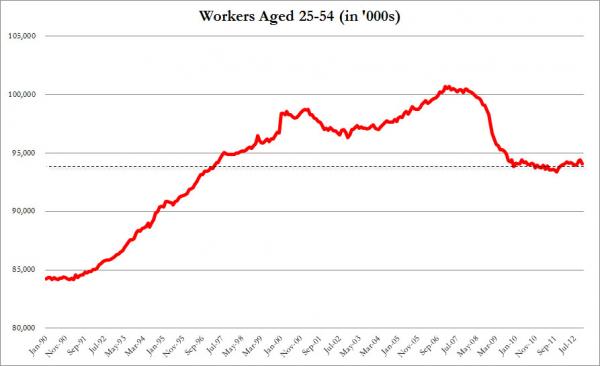When looking at long-term trends for higher education, it is useful to step back and look at the big picture. With this goal in mind, consider the comparison of post-secondary enrollment in degree-granting programs to the total number of jobs (both based on the US). The enrollment data is based on the National Center of Education Statistics (NCES) and the employment data is based on the Bureau of Labor Statistics and its Current Population Survey (CPS). To get the big picture I decided to keep this simple – combining full-time and part-time enrollment, and combining full-time and part-time employment. To see the trends, I normalized both data series to 1980.
When you look at the data from 1970 – 2012, the results could explain some significant pressures experienced by higher education institutions. In a nutshell – this time is different, we are in uncharted territory.
While the data speaks for itself, I would like to make a few points.
- The dominant feature of this data is that enrollment and employment started to diverge in an unprecedented fashion roughly in 2006. Enrollment growth accelerated at the same time that employment dropped, and there has not been a significant correction to this imbalance. Prior to this divergence, the growth of enrollment and total employment roughly tracked each other. We are now in uncharted territory. The magnitude of the divergence is roughly four times larger than any previous period.
- I do not believe that the sole purpose of higher education is college = get a degree = get a job. However, the availability of jobs for college graduates is one of the biggest drivers of the student debt level, which now exceeds auto loan and credit card debt.
- I think the biggest impact from this macro-economic trend is on those institutions most closely aligned to the goal of getting a job – community and technical colleges and much of the for-profit sector.
- I chose the date range (at Michael’s suggestion) to allow a comparison of the most recent recession (2008 – 2009) to previous recessions (notably 1973 – 75, 1980 – 82, 1990 – 91, and 2001). The conventional wisdom holds that enrollment jumps when employment drops, and the data does show some divergence followed a few years later by a correction. What is different this time is A) the magnitude of the divergence and B) the start of the divergence fully two years before the recession started in 2008.
- However bad this data is in terms of an imbalance between enrollment and employment, the reality is likely worse. Tyler Durden at Zerohedge posted similar employment data separated by workers aged 25-54 and aged 55-69. The former is essentially flat while most job growth in the past few years has been by those 55 and older. College graduates, however, are predominantly below 54.
Feel free to comment below or on Google+.
Update: So Dayna Catropa and I were pondering similar questions today. Her post at IHE is worth reading.



I appreciated greatly seeing this information – I hadn’t seen a similar comparison anywhere else. I’d affirm your conclusion that it’s different because the gap is now so great but don’t think the data “necessarily” supports that this time it started two years before the recession. The uptick at 2006 isn’t any greater than on many other occasions, it just kept on ticking when the recession eventually hit in 2008.
I have to wonder how much of the gap you show here can be attributed to the increased availability of pay-as-you-go higher education–opportunities to take a few credits at a time at a community college or an online provider? Does “normalized for 1980” factor for this relatively new phenomenon?
One way to interpret the gap might be that higher education is losing its effectiveness for career advancement, and people are wasting their money. The upshot would be that education is losing importance.
Another might be that people see an increased value in higher education to help hold on to or compete for what jobs do exist–so they invest in education. The upshot would be that education is gaining importance.
Each recession seems to lead to the permanent loss of some jobs, as employers use the recession as the opportunity to eliminate jobs whose value has been softened by increases in productivity due to technology or because those jobs can be moved overseas. So, the lower jaw in this gap might be where it is for these reasons, among others.
In any event, we used to think the economy in general and the labor market in particular would grow indefinitely and provide more and better jobs all the time. If this gap is as bad as it looks, it might be reflecting the end of that idea.
As a person who has worked in higher ed for 30 years, I worry about (further) erosion of public support (not just tax dollars, but the spending decisions families make with their own money) if education is viewed as an extravagance.
And as someone working in technology, I worry that we are using it to de-skill and eliminate jobs but not creating enough good new jobs.
Bob, I agree that the data is not definitive on the question of when the divergence starts in recent recession – treat that more as an observation that is worth considering. I do see, however, that the divergence from 2006-2008 (pre-recession) does appear larger than other pre-recession divergences. Needs further investigation.
Thomas, good question about the pay-as-you-go options. I might try to show data against FTE enrollment to try and capture this nuance, but that would not fully answer your question. Perhaps just showing against full-time enrollment. Thoughts on what would help address the question?
Phil,
Great post on the divergence of HE enrollment and employment. Tom mentions the government viewing education as an “extravagance”. I know what he is getting at, but I still think that those of us with both feet deeply in the waters of education technology are the outliers right now. Public perception is still STRONGLY in support of higher education as a means to prosperity in the U.S. When I get into dinner conversations about the future of higher education, most people find it difficult to think that will ever change.
What do I mean by this? While I agree that much of the ed tech disruption we are seeing will have a lasting effect on higher education, I think that public perception on the topic has a long way to go before we see serious economic changes to the space. I could be very wrong.
Keep up the great work.
Nick
Nick, thanks for comment (and tweet).